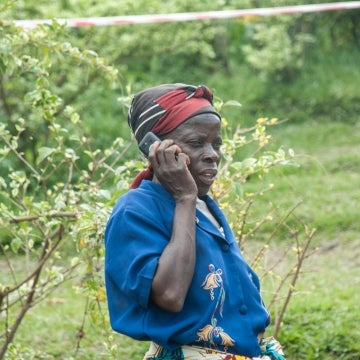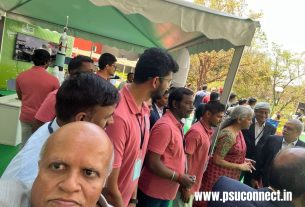‘Hey there, Mercy! Welcome to Farmer.Chat– my name is Grace. Need help finding something? Just ask me!’
For some, receiving the above message may bring a sense of optimism that relevant help is on the way; for others, frustration that this is clearly a robot (chatbot) and not a real person. But for rural women, who often have lower literacy levels and less access to smartphones and mobile internet than men, chatbots can be a game-changer.
By providing crucial information, chatbots can empower women to make better decisions. For smallholder farmers (SHF), this could mean higher productivity or a shift to climate-smart practices, strengthening resilience. With the right knowledge and greater agency, women can also gain financial independence.
Chatbots are AI-powered applications that use natural language processing (NLP) to understand questions and offer real-time responses via text or voice. Critically, they don’t always require the Internet; they can be operated through SMS or USSD (Unstructured Supplementary Service Data), allowing users to interact without an Internet connection. This is particularly useful for users in rural areas. Chatbots provide quick, contextualized responses at any point in the day, are low-cost or free to users, and don’t demand advanced digital skills.
From a business standpoint, chatbots are cost-efficient, improving efficiency by simultaneously responding to multiple customer inquiries, scaling and enhancing personalization easily, ensuring consistent communication, and improving (and tracking) user engagement.
They even cost-effectively support linguistic diversity to cater to diverse customer needs – communicating in multiple languages, translating messages in real-time, and adapting to local languages. This is especially pertinent in diverse and multilingual communities, such as India, where thousands of dialects are spoken.
How chatbots can serve rural women
In the last 60 years (!) chatbots have evolved from basic SMS-based bots following deterministic, scripted advice to powerful AI-driven assistants that offer conversational, real-time, multi-modal, personalized, and context-aware support (using NLP) in many local languages.
Chatbots are particularly salient for women, who often have lower traditional or digital literacy levels and may be less likely to own smartphones and use mobile internet. They can also democratize, access, and facilitate challenging conversations women may not be comfortable having with men, helping them access useful or sensitive information. Additionally, they can strengthen women’s decision-making by facilitating access to relevant information. For a woman smallholder farmer (SHF), this could lead to improved productivity or a transition to climate-smart farming practices, which helps her build resilience. The combination of relevant information and improved agency can also foster women’s financial independence.
In 2023, Digital Green developed Farmer.Chat: an AI-powered chatbot designed to provide real-time, personalized agricultural advice to small-scale farmers. Accessible via an Android app, Farmer.Chat allows farmers to ask questions using voice, text, or pictures in their local languages, overcoming digital literacy barriers. The chatbot delivers tailored recommendations on topics such as planting, irrigation, fertilization, and pest control, utilizing a vast repository of best practice videos and vetted data sources. This initiative aims to enhance the efficiency of agricultural extension services, promote climate resilience, and increase farmer productivity.
Designing chatbots for impact and inclusion
Despite the promise of chatbots, challenges remain, particularly for women at the last mile. Digital Green has responded in various ways.
Low digital and financial literacy
While voice notes and photos allow chatbots to circumvent literacy challenges, digital literacy, particularly for women, remains a challenge that limits the basic usability of chatbots.
Farmer.Chat AI assistant was first launched on familiar apps like Telegram and WhatsApp before introducing multimodal features like voice and pictures. Digital Green also onboards users in groups, such as Women’s Self-Help Groups (SHGs) and Farmer Producer Organizations (FPOs) to build digital confidence. Ongoing support is provided through the app with nudges and seasonal guidance.
Language
Most language models are trained on English-centric datasets. Digital Green ensures language accuracy by capturing real agricultural terms, collecting diverse voice samples, and refining small language models (SLMs) for low-resourced languages like Kikuyu, Bhojpuri, Hausa, and Nigerian Pidgin. Digital Green works with partners to gather and tag speech from diverse users, helping the AI models accurately reflect how farmers speak and making sure localized terms are not missed.
Reluctancy to use a new technology
Despite the ease of using Chatbots, some hesitations may prevent women from using them due to a lack of awareness about chatbots and their potential, lack of confidence in their ability to navigate them, or a lack of trust in them.
Digital Green tracks real-time gender-disaggregated Farmer.Chat data to understand women’s engagement—what they ask, how often they return, and if the chatbot aids their decisions. In Kenya, India, and Nigeria, women are slightly more active, sending 11.41 messages on average versus 9.75 for men. A 2024 60 Decibels study found that 61% of women and 55% of men in India reported improved quality of life within 45 days, citing greater self-reliance, efficiency, and better access to real-time agricultural advice.
Data costs
While data costs in India are amongst the lowest in the world, this is not the case everywhere – particularly important for women, who have lesser access to independent income. While Farmer.Chat is free, but data costs can be a barrier. In Kenya, where data is expensive, Digital Green partnered with Safaricom to offer zero-rated access. This enabled users to text, leave voice messages, or send photos at no cost—a model that Digital Green hopes will be replicated in other African countries. Safaricom users sent nearly 1.2x more messages, stayed engaged 1.3x longer, and sent more voice notes and photos than those without subsidized access, highlighting the impact of cost barriers on usage.
Trust and accuracy
Incorrect answers can erode trust and confidence, particularly among low-income women customers who are slow to adopt new technologies to begin with.
Digital Green is developing a high-quality or ‘Golden’ Q-A dataset—a curated set of expert-validated question-answer pairs to benchmark and evaluate Farmer.CHAT responses. They are open-sourcing this data as part of a broader effort to ensure consistent quality and contextual relevance of AI-generated advice and standardized benchmarks that also reflect the needs of women, climate resilience, and marginalized farmers. Regular feedback loops from real users also help refine responses, ensuring that Farmer.Chat provides reliable, context-aware support tailored to the needs and capabilities of diverse communities.
In-built biases
Chatbots are only as good as the data they are trained on. If that data is biased, the bias will be built into algorithms and the chatbot’s responses will also be biased.
Digital Green uses ‘red teaming’, where experts actively probe the chatbot with adversarial prompts to uncover gender bias, blind spots, and harmful stereotypes. By avoiding harm, Digital Green ensures the chatbot provides gender-responsive transformative advice—helping women navigate decision-making or resolve farm challenges with fewer inputs and limited labor. Digital Green systematically tests and refines the chatbot’s responses, using expert reviews, diverse testers, and an iterative feedback loop to ensure a more equitable, inclusive, and locally relevant agricultural advisor.
As of February 2025, Farmer.Chat has a significant base of 125,000 users and has received 1.5 million messages – offering a treasure trove of information on farmers’ concerns and queries on a week-to-week and crop cycle basis. Digital Green is launching a marketplace integration feature that allows users to access inputs and service providers.



